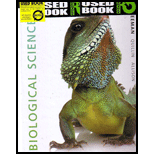
Concept explainers
Under what conditions does the rate of transpiration increase?
When the temperature of a leaf decreases
When stomata close at night
During rainstorms, when atmospheric pressure is low
When the weather changes and air becomes drier
Introduction:
Transpiration is defined as a process of loss of water molecules by means of evaporation from aerial parts of plants like leaves, stem and flower. Water is essential for the growth and metabolism of the plants, but a small amount of water is utilized by the plants, while most of it (97-99%) is lost in environment by means of transpiration and guttation. The specialized structures responsible for the process of transpiration are named as stomata. These are the pores present numerously in leaves and bordered by the guard cells and stomatal accessory.
Answer to Problem 1TYK
Correct Answer:
The process of transpiration is accompanied under two situations(1) when the stomata are open and (2) when the air of the external environment is drier than the plant’s internal environment.
Explanation of Solution
Explanation/Justification for the correct answer:
Option (d) is the correct answer. Here, it is given that the rate of transpiration is increases when the weather changes and air becomes drier, which is a true statement because the decrease in air humidity leads to an increase in transpiration.
Explanation for the incorrect answers:
Option (a) is given that rate of transpiration is increases when the temperature of leaf decreases, this statement is not true as increase in temperature always leads to an increase in transpiration, to cope up from the adverse effect of heat.
Option (b) is given that rate of transpiration is increases when the stomata close at night, this statement is not true as stomata are the pores responsible for the transpiration, so there is no transpiration when they are closed.
Option (c) is given thatrate of transpiration is increases during rainstorms when the atmospheric pressure is low, this statement is not true as rainstorms leads to an wet external environment with higher humidity, so condition is feasible for less transpiration.
Hence option (a), (b) and (c) are incorrect.
The rate of transpiration is depends upon many climatic factors, one important factor is air humidity so when the externa air is drier, the rate of transpiration is increases.
Want to see more full solutions like this?
Chapter 38 Solutions
Biological Science
- Not part of a graded assignment, from a past midtermarrow_forwardNoggin mutation: The mouse, one of the phenotypic consequences of Noggin mutationis mispatterning of the spinal cord, in the posterior region of the mouse embryo, suchthat in the hindlimb region the more ventral fates are lost, and the dorsal Pax3 domain isexpanded. (this experiment is not in the lectures).a. Hypothesis for why: What would be your hypothesis for why the ventral fatesare lost and dorsal fates expanded? Include in your answer the words notochord,BMP, SHH and either (or both of) surface ectoderm or lateral plate mesodermarrow_forwardNot part of a graded assignment, from a past midtermarrow_forward
- Explain in a flowcharts organazing the words down below: genetics Chromosomes Inheritance DNA & Genes Mutations Proteinsarrow_forwardplease helparrow_forwardWhat does the heavy dark line along collecting duct tell us about water reabsorption in this individual at this time? What does the heavy dark line along collecting duct tell us about ADH secretion in this individual at this time?arrow_forward
 Biology: The Unity and Diversity of Life (MindTap...BiologyISBN:9781337408332Author:Cecie Starr, Ralph Taggart, Christine Evers, Lisa StarrPublisher:Cengage Learning
Biology: The Unity and Diversity of Life (MindTap...BiologyISBN:9781337408332Author:Cecie Starr, Ralph Taggart, Christine Evers, Lisa StarrPublisher:Cengage Learning Biology (MindTap Course List)BiologyISBN:9781337392938Author:Eldra Solomon, Charles Martin, Diana W. Martin, Linda R. BergPublisher:Cengage Learning
Biology (MindTap Course List)BiologyISBN:9781337392938Author:Eldra Solomon, Charles Martin, Diana W. Martin, Linda R. BergPublisher:Cengage Learning Biology 2eBiologyISBN:9781947172517Author:Matthew Douglas, Jung Choi, Mary Ann ClarkPublisher:OpenStax
Biology 2eBiologyISBN:9781947172517Author:Matthew Douglas, Jung Choi, Mary Ann ClarkPublisher:OpenStax Biology Today and Tomorrow without Physiology (Mi...BiologyISBN:9781305117396Author:Cecie Starr, Christine Evers, Lisa StarrPublisher:Cengage Learning
Biology Today and Tomorrow without Physiology (Mi...BiologyISBN:9781305117396Author:Cecie Starr, Christine Evers, Lisa StarrPublisher:Cengage Learning
 Biology: The Dynamic Science (MindTap Course List)BiologyISBN:9781305389892Author:Peter J. Russell, Paul E. Hertz, Beverly McMillanPublisher:Cengage Learning
Biology: The Dynamic Science (MindTap Course List)BiologyISBN:9781305389892Author:Peter J. Russell, Paul E. Hertz, Beverly McMillanPublisher:Cengage Learning





